Abstract
Vegetable production is an important agricultural sector in Syria, with tomatoes and eggplants being major crops. According to data for 2022, eggplant production volume was the highest, reaching 141kt, supported by a long-established production base and high demand. Tomatoes vary greatly in terms of their uses; in addition to being eaten raw, there is also high demand for processed foods (paste and juice). Demand for tomatoes, especially for processing, is stable in both domestic and international markets, and dedicated cultivation land has been secured for this purpose. From a land use perspective, agricultural land in Syria is subject to limited water resources and climatic conditions, and water-efficient crops (tomatoes and eggplants) tend to be grown there. These crops are easily adapted to dry climates and are therefore widely grown, especially in the north and inland areas. In contrast, crops that require more moisture have limited cultivation areas and are highly dependent on a stable supply. Overall, Syria’s vegetable production is well balanced between domestic consumption and export, and production volumes of tomatoes and eggplants may continue to increase or decrease depending on demand.
Production (by vegetables)
Looking at the long-term trends in vegetable production in Syria, there are notable fluctuations, especially in cucumber production. From 1961 to 2022, cucumber production peaked at 350kt in 1983, but production has declined since then and is currently at only 35.8% of its peak. This decline is thought to be due to changes in the agricultural environment within Syria, as well as economic and social factors. Since the late 1980s, Syria has been hit by civil war and political and economic instability, which has had a severe impact on agricultural production. In particular, the damage to water sources and infrastructure necessary for cucumber cultivation, which reduced the efficiency of agricultural production, is thought to have led to the decrease in cucumber production. Lack of progress in irrigation facilities and agricultural technology may also have played a role, and there may have been a lack of investment to support harvests. On the other hand, despite the decline in cucumber production, production of other vegetables in Syria (especially tomatoes and eggplants) has remained stable, supported by stable demand for these crops both domestically and in export markets. Depending on future agricultural policies and the reconstruction of infrastructure, cucumber production may be able to recover, but this will require an improvement in the overall agricultural environment.
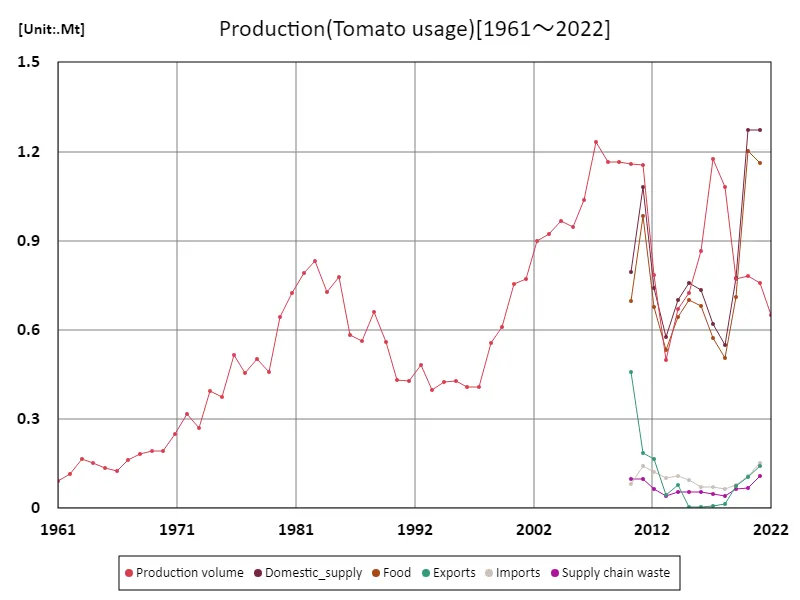

The maximum is 1.27Mt[2020] of Domestic_supply, and the current value is about 100%
Yield(by vegetable)
Tomato is one of the important crops in Syria’s vegetable production, and in 2018 the yield reached a peak of 76.8t/ha. However, data from 2022 shows that current tomato yields are only 63.2% of their peak. This fluctuation reflects the multiple challenges that Syrian agriculture has faced. Tomato production peaked in 2018, driven by increased domestic demand and stable supply. Tomatoes are in high demand both for eating fresh and for processing (tomato paste and juice), and exports have been particularly active to the Middle Eastern and Asian markets. However, the subsequent decline in yields is believed to be primarily due to the effects of the Syrian civil war, economic instability, and the destruction of agricultural infrastructure. Deteriorating irrigation systems, a decrease in farmland, and a shortage of agricultural labor have had a direct impact on the efficiency of tomato cultivation. In addition, climate change and extreme weather conditions are also having a negative impact on crops, with water scarcity, especially in arid regions, hindering tomato production. These factors have led to a decline in tomato yields per unit area. There is a possibility that tomato yields will recover in the future as agricultural techniques and infrastructure are restored, but for this to happen, stable agricultural support and a recovery in the market are essential.
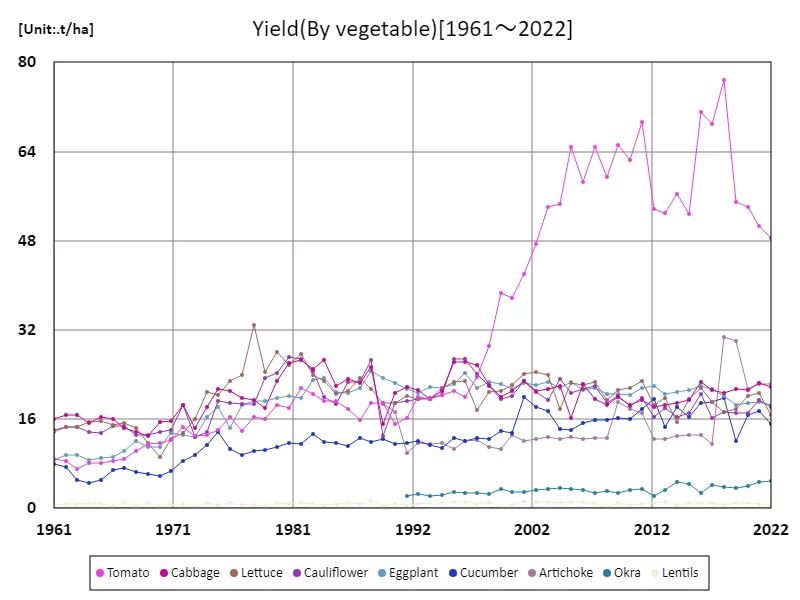

The maximum is 76.8t/ha[2018] of Tomato, and the current value is about 63.2%
Land use (by vegetables)
Looking at the land use situation for vegetable production in Syria in 2022, lentils are cultivated on the largest area, reaching 81.4 kha. This indicates that lentils are an important crop in Syrian agriculture. Lentils grow easily in dry areas, making them an efficient crop in areas with limited water resources, such as Syria. As a result, lentil cultivation is the largest in Syria, especially in the northern and eastern regions. Meanwhile, the total agricultural land area of Syria is 121 kha, of which the area cultivated with vegetables other than lentils (such as tomatoes and eggplants) is relatively small, averaging around 13.4 kha. This land use distribution reflects the characteristics of agriculture in Syria. In particular, in areas with limited water resources, water-efficient crops tend to be cultivated preferentially, which may be one of the reasons why drought-resistant crops such as lentils are chosen. Additionally, agriculture in Syria has been affected by the civil war and economic instability, and there are challenges in terms of efficient land use and infrastructure development. This has resulted in fluctuations in the area of cultivated crops from year to year, with a particular tendency for the area of crops that require large amounts of water to decrease. In order to optimize land use, future challenges will include selecting crops that are adapted to climatic conditions and introducing efficient irrigation techniques.
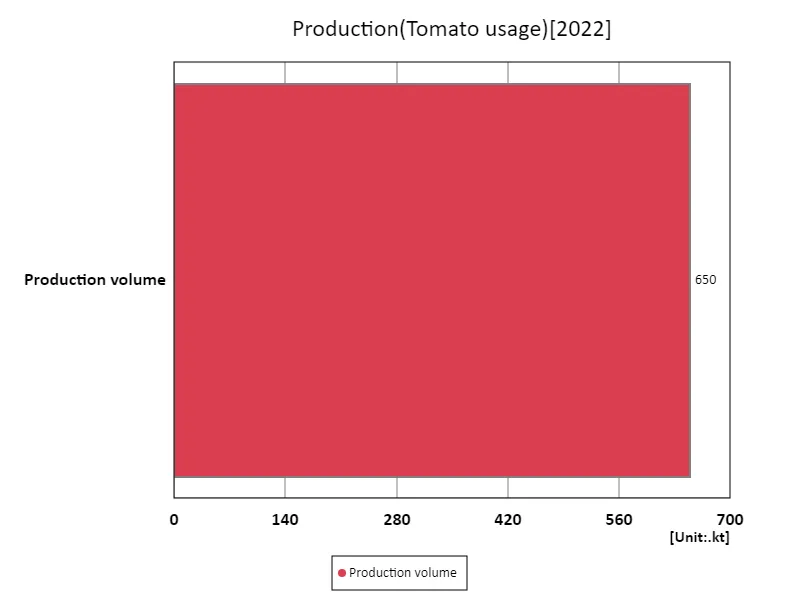

The maximum is 650kt of Production volume, the average is 650kt, and the total is 650kt
Tomato usage
Regarding tomato production by use in Syria, data from 1961 indicates that domestic supply of tomatoes reached a maximum of 1.27 Mt, indicating that Syria was a major tomato producing country. Tomatoes play an important role in Syrian agriculture, with their main uses divided between eating fresh and processing. Demand for it as food, in particular, is supported not only by the domestic market but also by exports to neighboring countries, making it a major crop in Syria’s agricultural economy. Another important use is for processed tomatoes (juice, paste, ketchup, etc.), and the processing industry is developing due to stable supply and high market demand. Syria is a major supplier of tomatoes in the Middle East, and at one time export tomatoes were grown on a scale that exceeded domestic production. However, the recent Syrian civil war and economic instability have had a severe impact on agricultural production, particularly on tomato production volumes and supply stability. The collapse of agricultural infrastructure and limited access to export markets have led to a contraction in domestic supplies. As a result, although current tomato production is lower than at its peak, it remains an important crop for Syria, especially for domestic consumption. Improved agricultural techniques and resumption of market access will be key for future recovery.
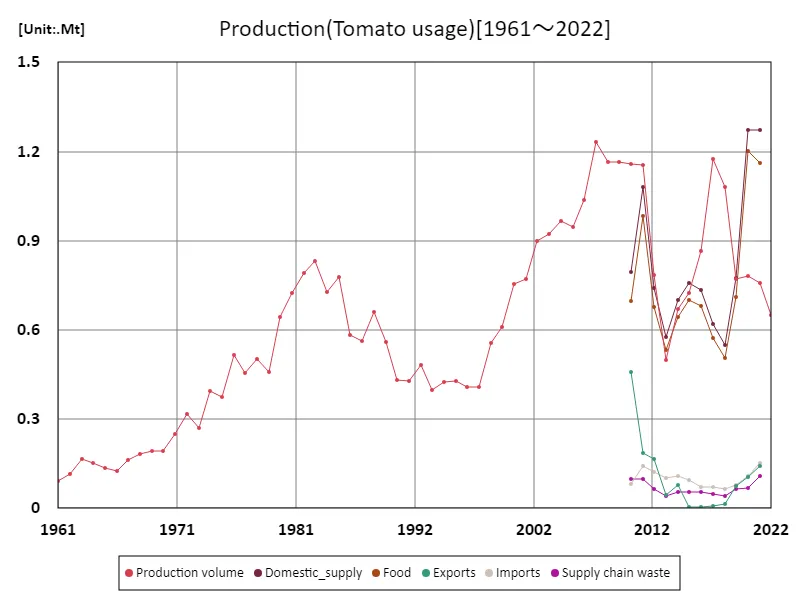

The maximum is 1.27Mt[2020] of Domestic_supply, and the current value is about 100%
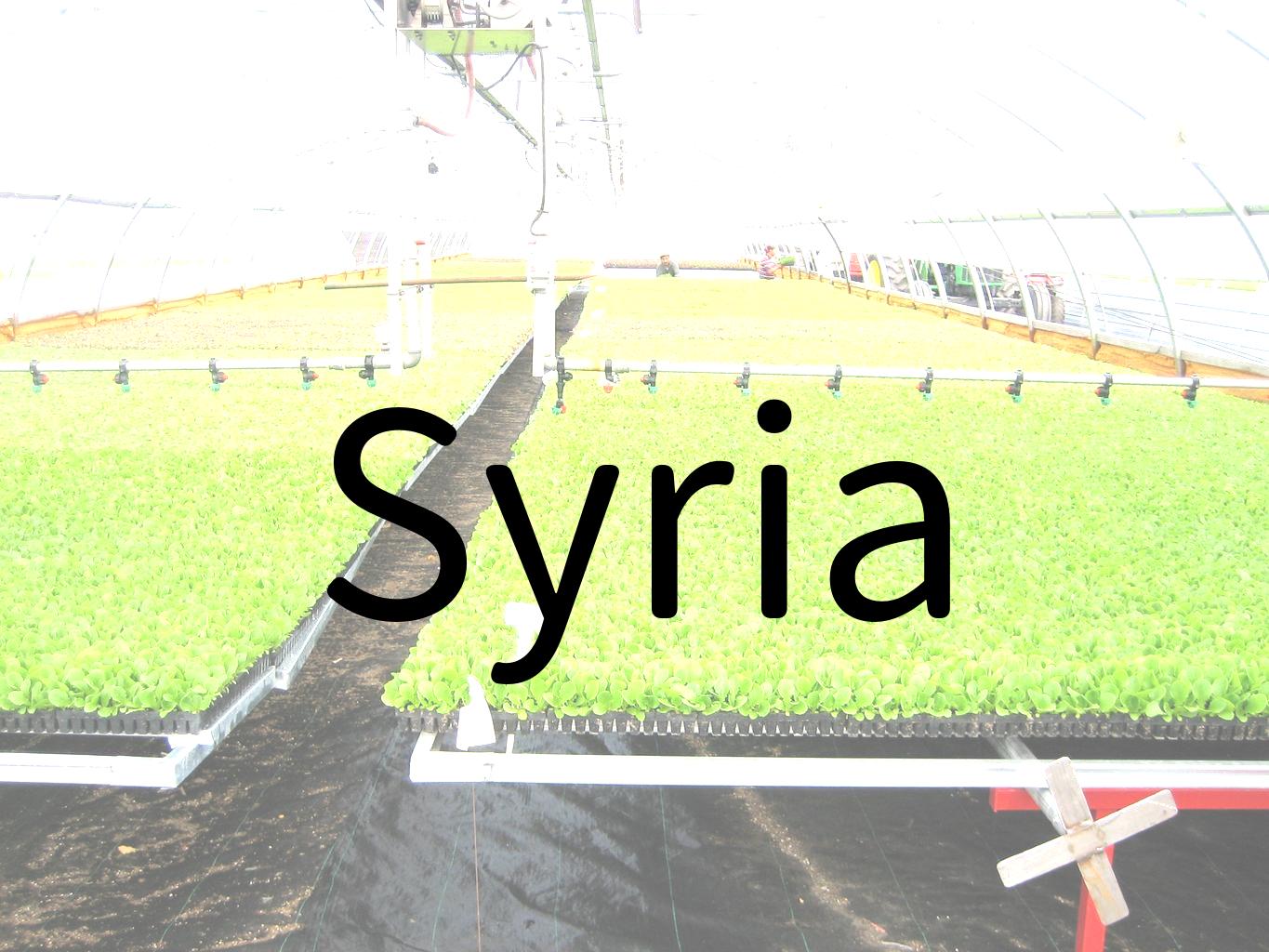


Comments